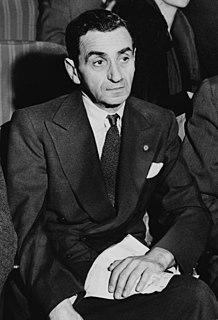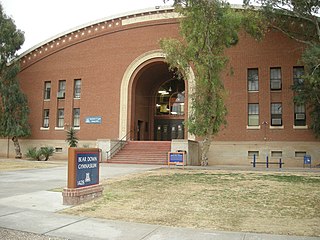
Irving Berlin was a Russian-American composer, songwriter and lyricist. His music forms a large part of the Great American Songbook.
Blue-eyed soul is rhythm and blues and soul music performed by white artists. The slang, coined in the mid-1960s, was invoked by music magazines in the 1960s such as Life who used it for the Righteous Brothers, Barry McGuire, Sonny & Cher; other times it meant style and mannerisms associated with soul music sung by white musicians. Though many rhythm and blues radio stations in the United States in that period would only play music by black musicians, some began to play music by white acts considered to have "soul feeling" and their music was then described as "blue-eyed soul."
A fight song is a rousing short song associated with a sports team. The term is most common in the United States and Canada. In Australia, Mexico, and New Zealand these songs are called the team anthem, team song, or games song. First associated with collegiate sports, fight songs are also used by secondary schools and in professional sports.

"You're a Grand Old Flag" is an American patriotic march. The song, a spirited march written by George M. Cohan, is a tribute to the U.S. flag. In addition to obvious references to the flag, it incorporates snippets of other popular songs, including one of his own. Cohan wrote it in 1906 for his stage musical George Washington, Jr.

Starflyer 59 is an American alternative rock band from Riverside, California that was founded in 1993 by Jason Martin, brother of Ronnie Martin of Joy Electric. While Jason Martin has written nearly all of Starflyer 59's songs, the band has included a number of different musicians over the years, including Jeff Cloud, Frank Lenz, and Richard Swift. The band's sound was initially identified as an outgrowth of the shoegaze movement of the early 1990s, but the band's music has gradually evolved to the point of little resemblance to that of its early days.
The University of Alabama is a school with many traditions. This article describes several of these traditions.

"Bear Down" is the official motto of the University of Arizona, located in Tucson, Arizona. It is the inspiration for "Bear Down, Arizona!," the unofficial fight song of the school's Arizona Wildcats. The official fight song is "Fight! Wildcats! Fight!" written by Douglas Holsclaw.
Go, You Redbirds is the fight song for the athletic teams of Illinois State University. It was written in 1932 by Kenyon S. Fletcher. The words have been changed from time to time. Prior to the fight song we know today, the Illinois State fight song was "Normal Loyalty." At sporting events when an ISU athletic team enters the field or floor, the students and fans sing the first stanza of “Go, You Redbirds.” A new growing Redbird tradition amongst several redbird teams is to sing the fight song with the marching band to the home crowd after victories. The line "Lets win this game" is changed to "We've won this game."
Minnesota March is a march for wind band written by John Philip Sousa for the University of Minnesota. The piece was one of four marches written by Sousa expressly for a university. It is now used as one of the university's school songs, with lyrics written in 1927 by university band director Michael Jalma. The piece is regularly performed by the University of Minnesota Marching Band and pep bands and often sung by students at various athletic events and ceremonies.
"Fight On, State" is the official fight song of The Pennsylvania State University. It is most widely known for being played by the Penn State Blue Band after scores at football games, and during the band's pregame show. It is written specifically to be played after a touchdown, as it slows down quickly toward the end of the song, then stops. It then resumes after the team kicks an extra point and is played again at regular speed.

"We Are the Boys from Old Florida" is a song commonly played and sung during University of Florida (UF) sporting events, most notably at the end of the third quarter at football games by The Pride of the Sunshine, the school's marching band. It is very similar to other school songs sung by several other colleges and schools around the United States, and its origin and original composer is unknown. At Florida, it has been popular since the 1920s.
"Victory" is an old fight song of the Pennsylvania State University. It is most often sung by the Penn State Glee Club and performed by the Penn State Blue Band.

"There Goes Old Georgetown" is the unofficial name of the Georgetown University sports teams' fight song. It is also known as simply "Georgetown Fight Song". It is actually an amalgamation of three songs, only the oldest of which, 1913's "The Touchdown Song", contains the lyric "here goes old Georgetown". Onto a version of this was added "Cheer for Victory", written in 1915, and "The Hoya Song", written in 1930, both of which are included in their entirety. The authors of these songs, and of the combined version, are unknown. Although some effort has been taken to change the song, no serious proposal has come forth.
"Sons of California" is a fight song of the University of California, Berkeley, as well as the University of California, Davis. It was composed by Clinton "Brick" Morse in 1896. Although it was originally an unpopular song among students because of its slow and solemn hymn, the Cal Band began performing a more lively version in the 1930s. From then on, "Sons of California" would remain one of the best known songs at the University.

The Thunder of the East is the marching band of the University at Buffalo in the State University of New York system. UB's first marching band was created in 1920, and disbanded in 1927. It was revived in 1946, increasing in size and reputation until about 1970. It was known as "The Pride of the East." At that time, it was dissolved upon UB's departure from Division I athletics. In 1981, some UB students continued the tradition of playing music at UB's home football and basketball games by forming UB's Pep Band. In anticipation of UB's return to Division I athletics, a marching band was formed in 1999 and named, "Thunder of the East." The band debuted at the University at Buffalo Stadium on September 11, 1999. The Thunder of the East is currently led by James E. Mauck; and performs at UB's Buffalo Bulls home football games, as well as in other musical venues.

"Hail to Pitt" is the most traditional fight song of the University of Pittsburgh, which is commonly referred to as Pitt. The saying "Hail to Pitt!" is also the most traditional and commonly used slogan of the University of Pittsburgh and its athletics teams. The slogan is frequently used in promotional material, printed on merchandise and souvenirs. It was also the title of a 1982 history of Pitt athletics by author Jim O'Brien. The slogan is often used among alumni as a statement of affiliation, including as a closing signature in conversation or correspondence between alumni, and is sometime abbreviated as "HTP" or "H2P", the latter of which is a registered trademark of the university and is frequently used on official university signage and merchandise.
"March On! " is the official school fight song of Indiana State University. The song and lyrics were written by ISU professor of music Joseph A. Gremelspacher as a pep song.
British soul, Brit soul, or the British soul invasion, is soul music performed by British artists. Soul has been a major influence on British popular music since the 1960s, and American soul was extremely popular among some youth subcultures, such as mods, skinheads, and the Northern soul movement. In the 1970s, soul gained more mainstream popularity in the UK during the disco era.
"Varsity" is a fight song of the University of Michigan.








